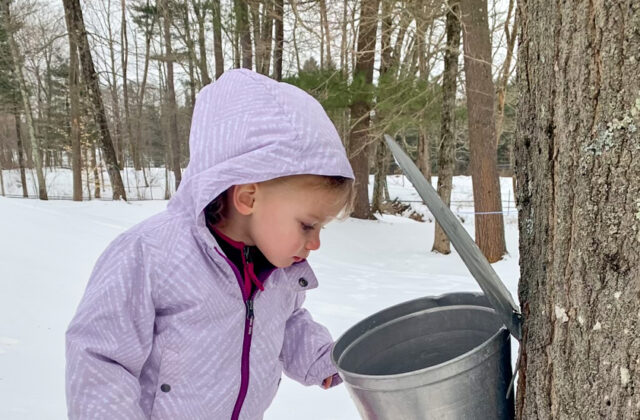Cold Nights and Warmer Days Herald a New Maple Syrup Season
Text by Jude Mead
Photo by Danesha Mead
Maple syrup season is here again. This year will be a little different, with Covid-19 guidelines that still need to be followed. In years past, visitors were welcomed to the sugar houses. This year there will be more safety measures in place and visitors discouraged from coming. But according to Thomas Worthley, associate extension professor at the University of Connecticut, the limitation on visitors will not affect the maple season itself. “Maple producers will still be heading out to tap trees, and it should still be a traditional maple year,” said Worthley.
Some maple sugar houses, however, have decided not to boil this year. Mary O’Neill, the director of communications at Great Mountain Forest, said that they will not be open this season because of the risks presented by Covid-19. “Great Mountain Forest is suspending its maple syrup production for the 2021 season. We do this out of an abundance of caution for our employees and the local community,” said O’Neill.
But many other producers will still be making maple syrup this season. Aaron Wightman, a maple specialist and co-director for the Cornell Maple Program, explained that maple syrup production is weather dependent, and the conditions dictate the success of the season. “The days need to have above-freezing temperatures and the nights need to be cold for the sap to flow. This cycle of freezing and thawing temperatures during the dormant season when the tree has no leaves and is not actively growing creates a vacuum pressure cycle inside maple trees. When they freeze, the shrinkage of gases in the trunk creates a vacuum which draws moisture up from the soil. If the tree then thaws, the gases expand and create pressure inside the tree. When a tree is tapped this pressure pushes sap out of the tap hole,” said Wightman.
Wightman said that on a good day a tree can produce around two gallons of sap. “This is highly variable and depends on the characteristics and weather conditions of individual trees. Trees should be a minimum of ten inches in diameter before being tapped. It takes somewhere in the range of 40 to 80 years for a healthy maple to attain this size.”
Some people worry that tapping a tree harms it, but Wightman said that trees have an internal defense mechanism called compartmentalization. This process blocks off the tissue around a taphole to harden it against infection. “The tree grows over the tap hole, so even if there is an injury, it is not enough to measurably impact the health of a tree,” he said.
Once the maple sap is collected, it is then turned into syrup through an evaporation process. This process separates sugar and other minerals from the water. It takes about 40 gallons of sap to make a gallon of syrup, but this varies depending on the sugar content of the sap. “How much sugar is actually in maple sap is highly variable from year to year. The canned answer that’s usually given is 2 percent sugar in maple trees. Trees that grow in yards or fields often have the highest sugar content because they have large crowns and little competition from other trees. It’s not uncommon to get 3 to 4 percent from a yard tree. That’s one reason why backyard sugaring from just a few trees is often very rewarding.” said Wightman.
When the thermometer in the evaporator pan reaches 219 degrees, the sap has turned to syrup and is ready to be drawn off. It will then be filtered and graded. The color and taste of pure maple syrup vary, and consumers have their own preferences. Early in the season the syrup is light with a slightly sweet taste. As the season progresses, the syrup develops a dark robust color with a more pronounced maple flavor. The darkest and strongest tasting syrup comes at the end of the season.
Wightman is often asked about the health benefits of syrup for both people and the environment. Apparently, maple syrup not only tastes delicious but has beneficial properties. “Maple syrup contains essential vitamins and nutrients. It also contains compounds that are anti-inflammatory,” said Wightman. “It is also healthier for the environment. Other sweeteners like cane sugar are grown in intensive agricultural systems and converted into sugar through a heavy refinement process. In contrast, maple sap is collected from forest ecosystems and processed into maple syrup through the simple act of boiling. It is locally and sustainably produced.”
So maple syrup is a healthy and enjoyable food to produce. Jody Bronson, the head forester at Great Mountain Forest, summed it up well. “I enjoy it when people want to learn about maple syrup, and I encourage their interest. I think it is important for everyone to know how maple trees produce syrup.” This pure, all-natural product is here to stay.

